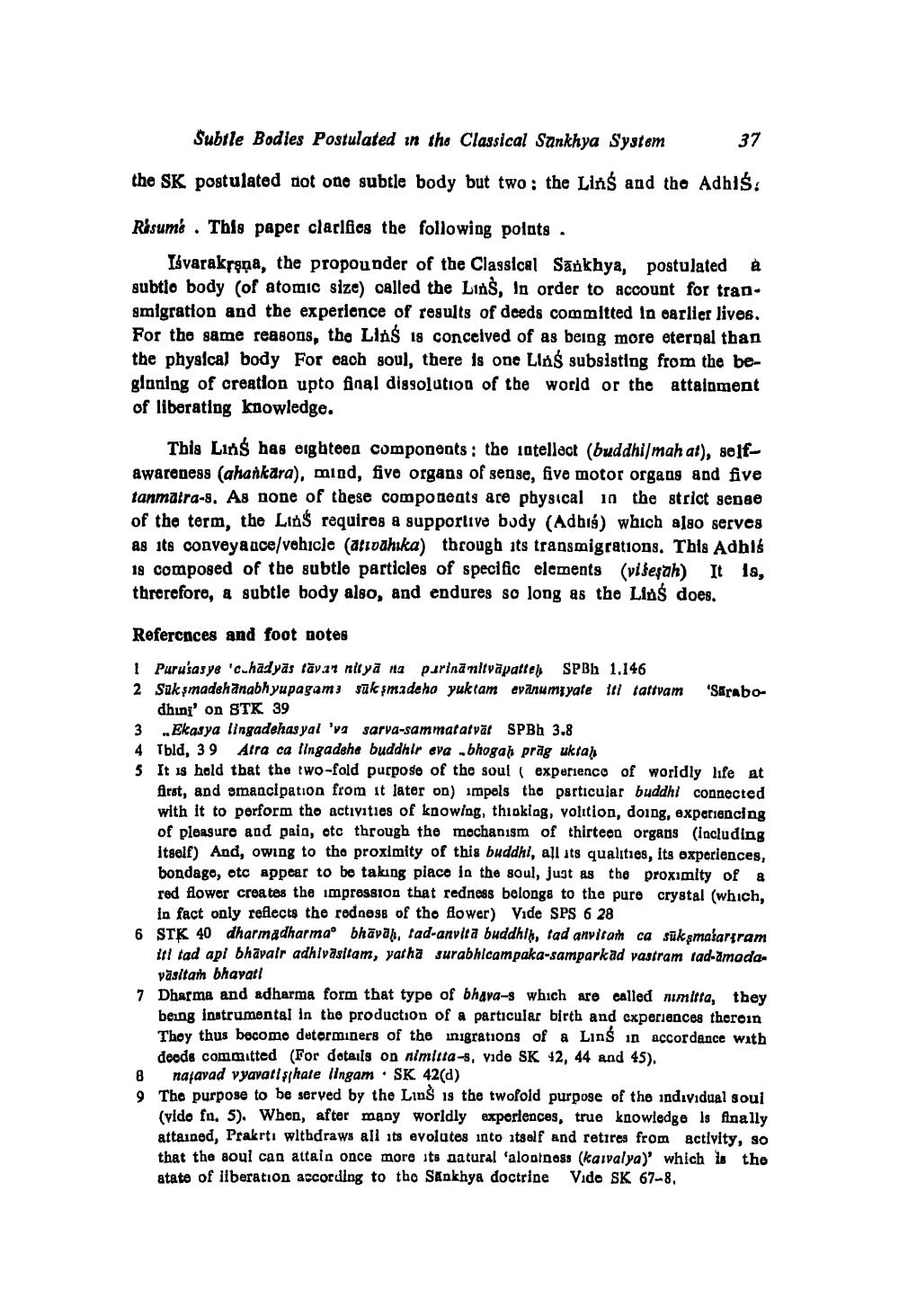________________
Subtle Bodies Postulated in the Classical Sankhya System
37
the SK postulated not one subtle body but two: the Lins and the Adhis:
7
.
Résumé . This paper claclfies the following points .
Isvarakršna, the propounder of the Classical Sankhya, postulated subtlo body (of atomic size) called the Lins, in order to account for tran. amigration and the experience of results of deeds committed in earlier lives. For the same reasons, the Lins 18 conceived of as being more eternal than the physical body For each soul, there is one Lins subsisting from the beglaning of creation upto final digsolution of the world or the attainment of liberating knowledge.
This Linś has erguteen components: the intellect (buddhi/mah at), selfawareness (ahankara), mind, five organs of sense, five motor organs and five tanmatra-8. As none of these components are physical in the strict sense of the term, the Lins requires a supportive body (Adbis) which also serves as its conveyance/vehicle (arivahika) through its transmigrations. This Adhis 18 composed of the subtle particles of specific elements (višeşah) It Is, threrefore, a subtle body also, and endures so long as the Linś does.
yai 'va sarvar eva -blogak pexperience
References and foot notes 1 Purusayye 'chadyas dāvan niya na purina nitvāpatten SPBh 1.146 2 Suksmadehānabhyupagam: sūksmadero yuktam evanumiyafe thi tattvam 'Sarabo
dhinr' on STK 39 3 Ekasya lingadehasyal 'va sarva-sammatarvāt SPBh 3.8 4 Tbld, 39 Atra ca tingadehe buddhir eva bhogah prāg ukra) 5 It is hold that the two-fold purpose of the soul (experience of worldly life at
first, and smancipation from it later on) impels the particular buddhi connected with it to perform the activities of knowing, throking, volition, doing, experiencing of pleasure and pain, etc through the mechanism of thirteen organs (including Itself) And, owing to the proximity of this buddhi, all its qualities, its experiences, bondago, etc appear to be taking place in the soul, just as the proximity of a red flower creates the impression that redness belongs to the pure crystal (which,
in fact only reflects the rodnose of the flower) Vide SPS 6 28 6 STK 40 dharmadharma' bhāvah, tad-anvita buddhis, tad anvitam ca sükşmalar ram
ini tad api bhāvair adhivasitam, yarha surabhicampaka-samparkad vastram tad-amoda.
väsitam bhayati 7 Dharma and adharma form that type of bhava-s which are called nimitra, they
being instrumental in the production of a particular birth and experiences theroin Thoy thus becomo determiners of the inigrations of a Lins in accordance with deeds committed (For details on nimitta-3, vide SK 42, 44 and 45).
najavad vyavati shate lingam .SK 42(d) 9 The purpose to be served by the Ling is the twofold purpose of the individual soul
(vido fn. 5). When, after many worldly experiences, true knowledge is finally attained, Prakrti withdraws all its evolutes into itself and retires from activity, so that the soul can attain once more its natural 'alodnos (kaivalya)' which is the atate of Ilberation according to tho Sankhya doctrine Vido SK 67-8.




